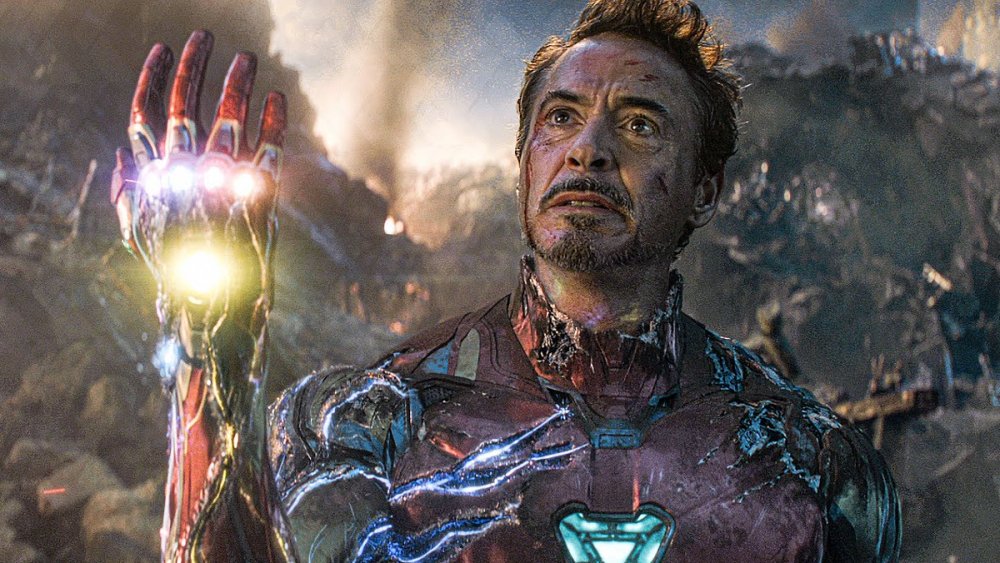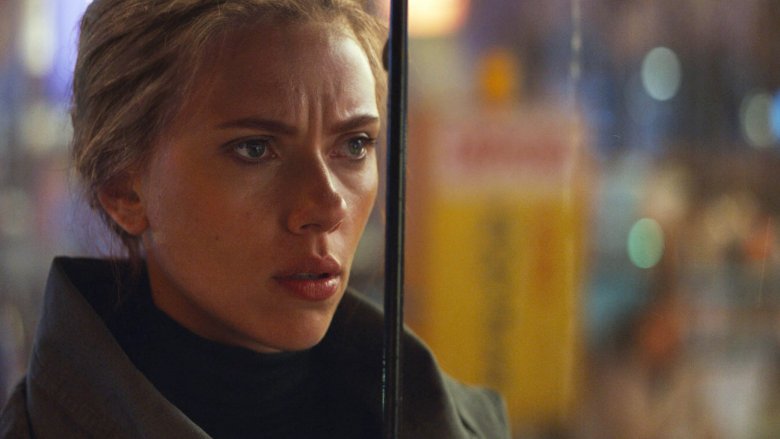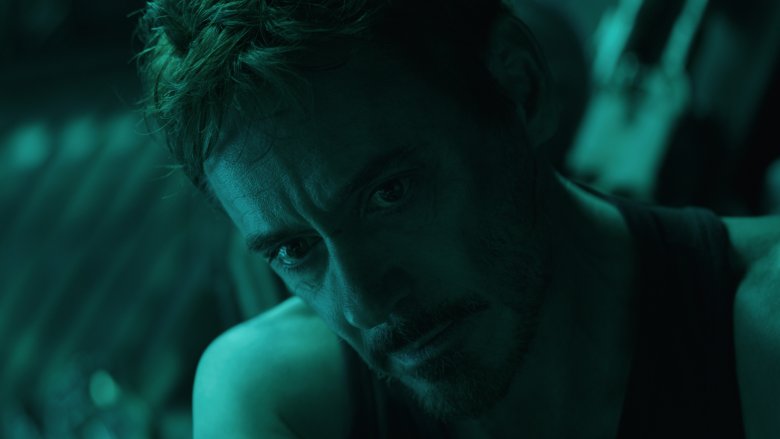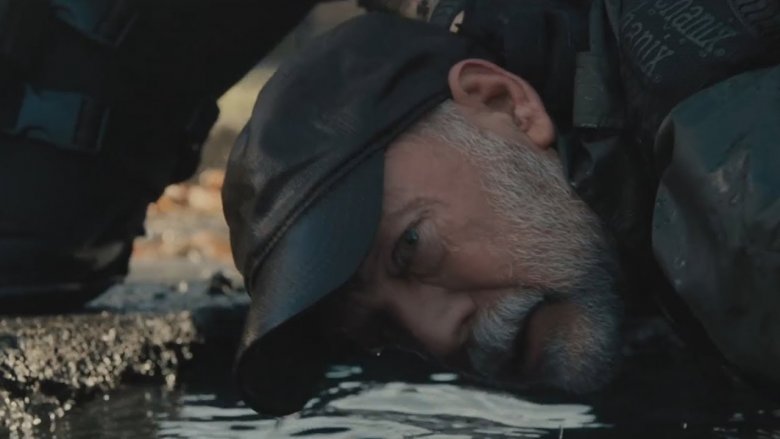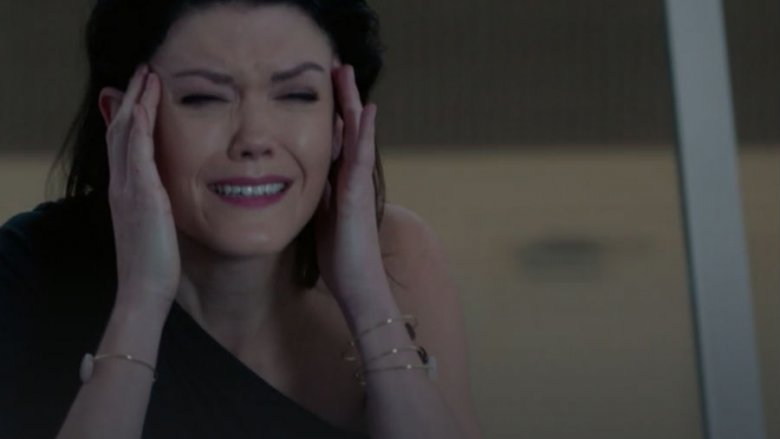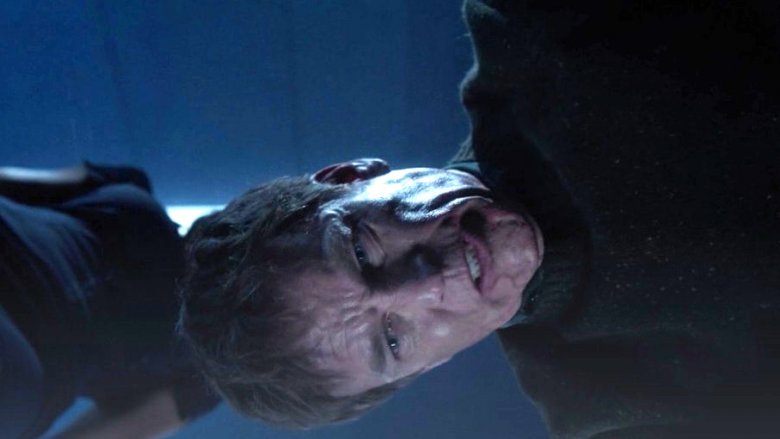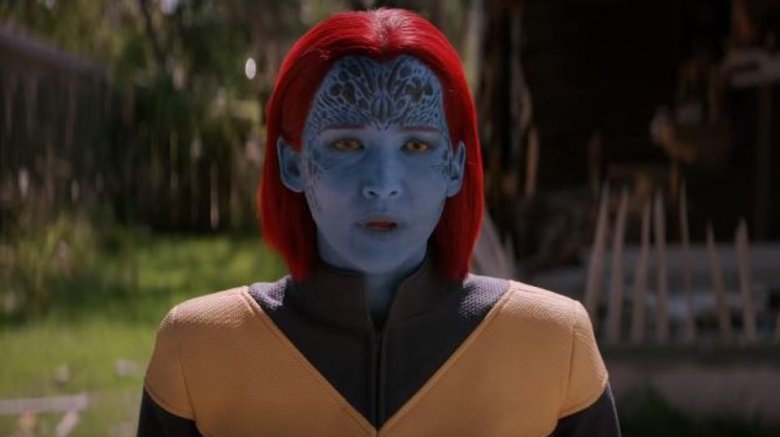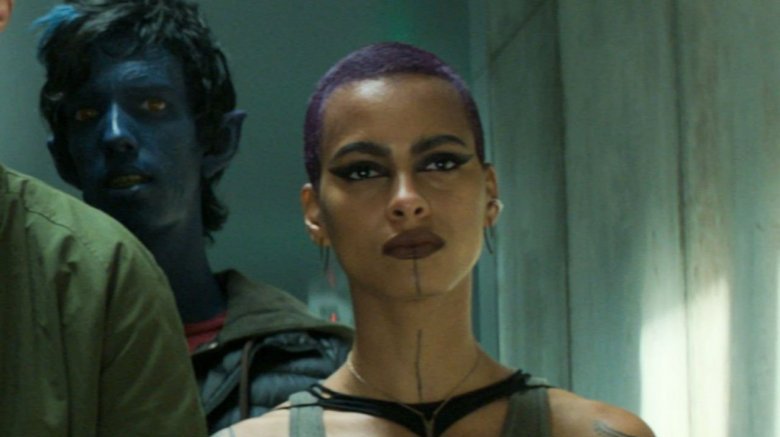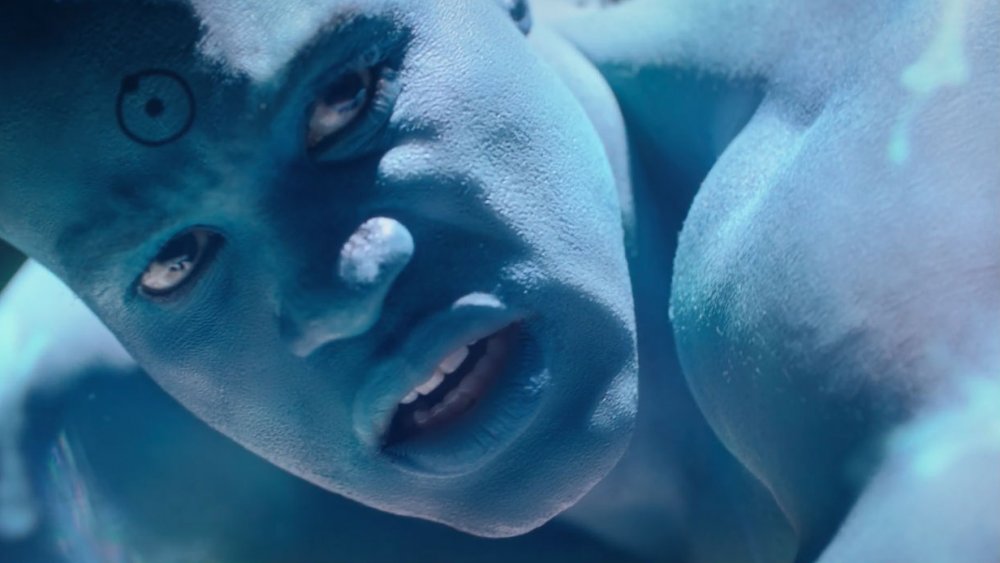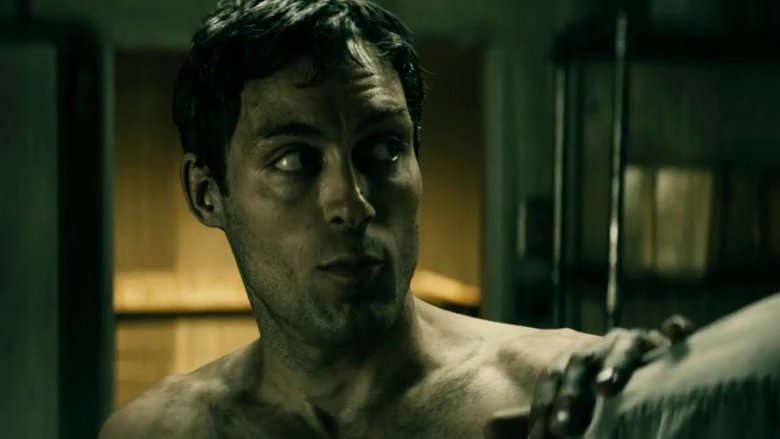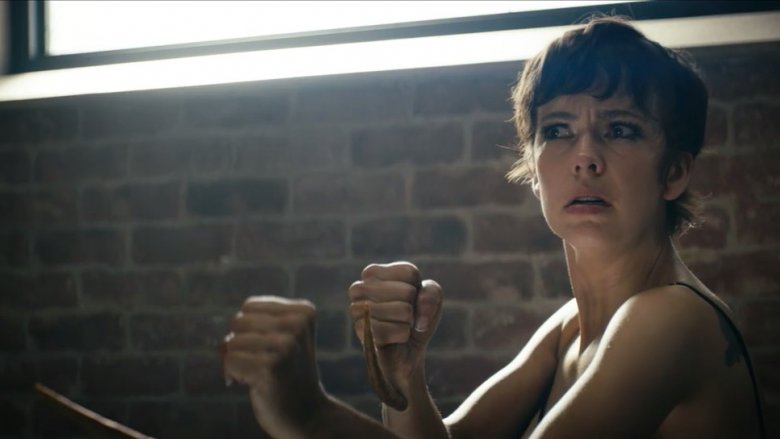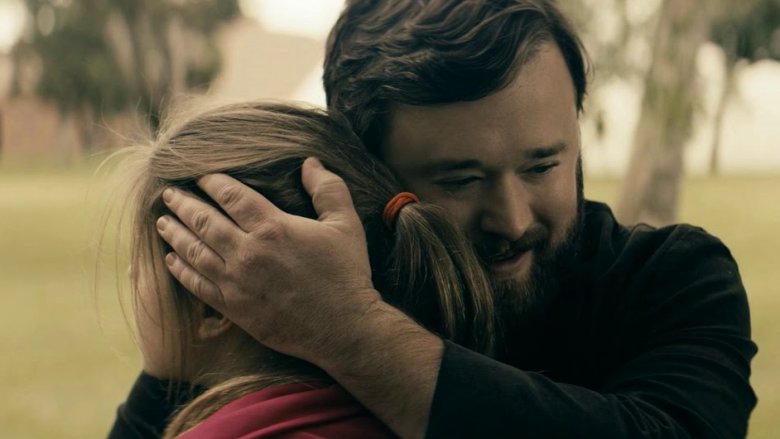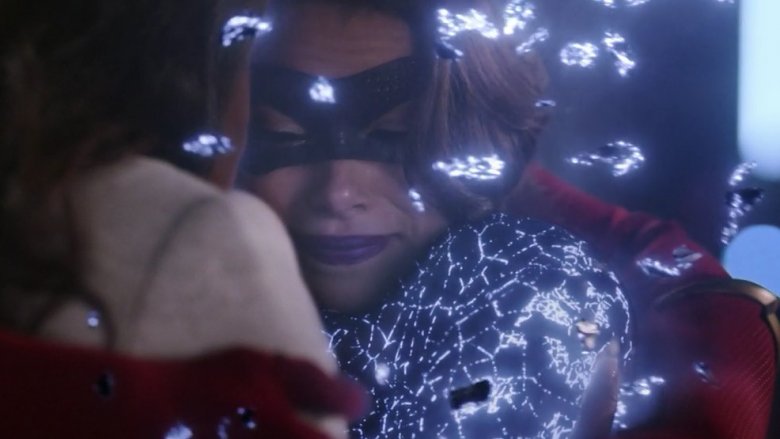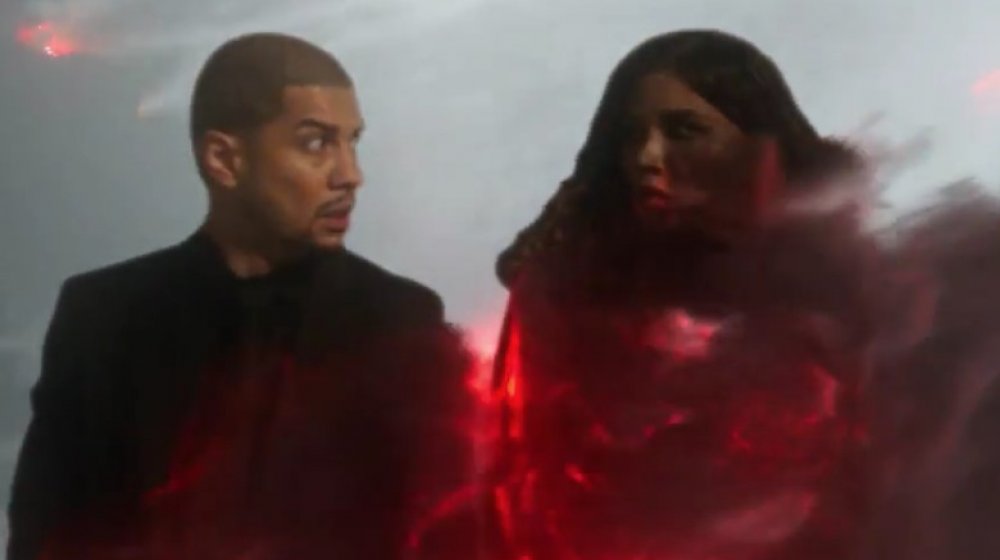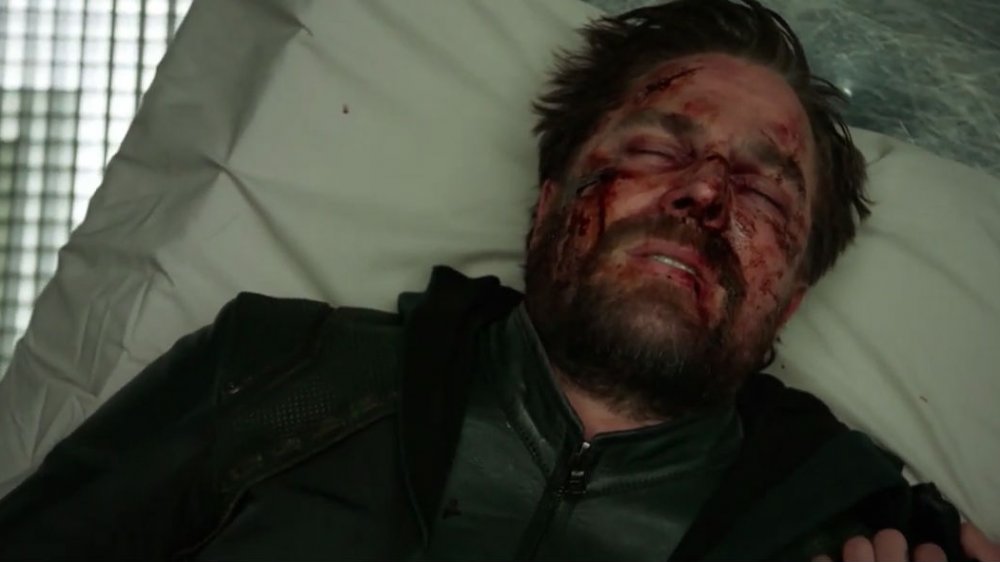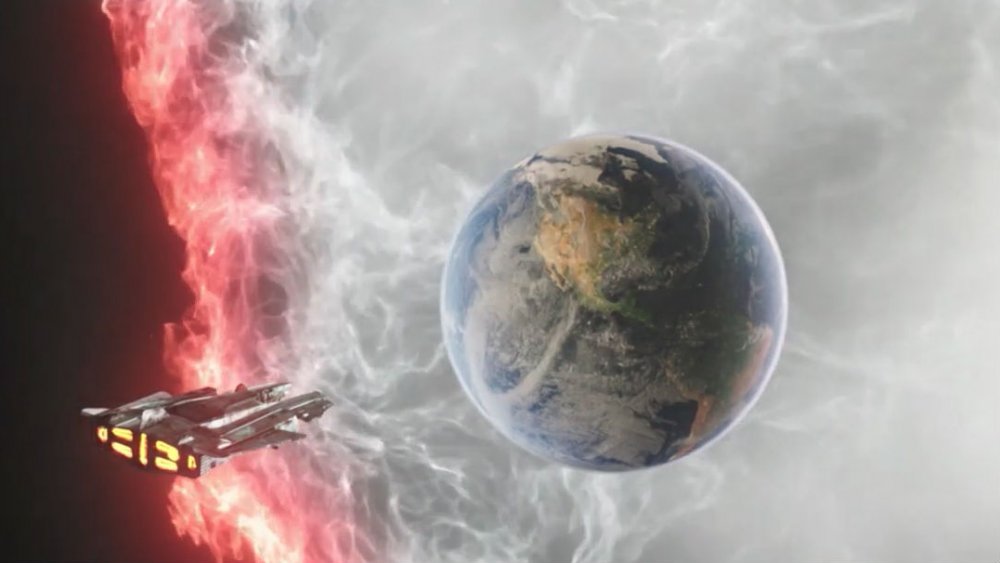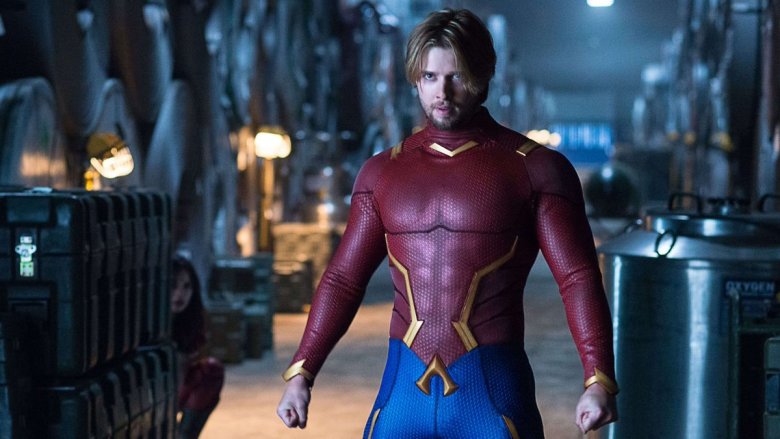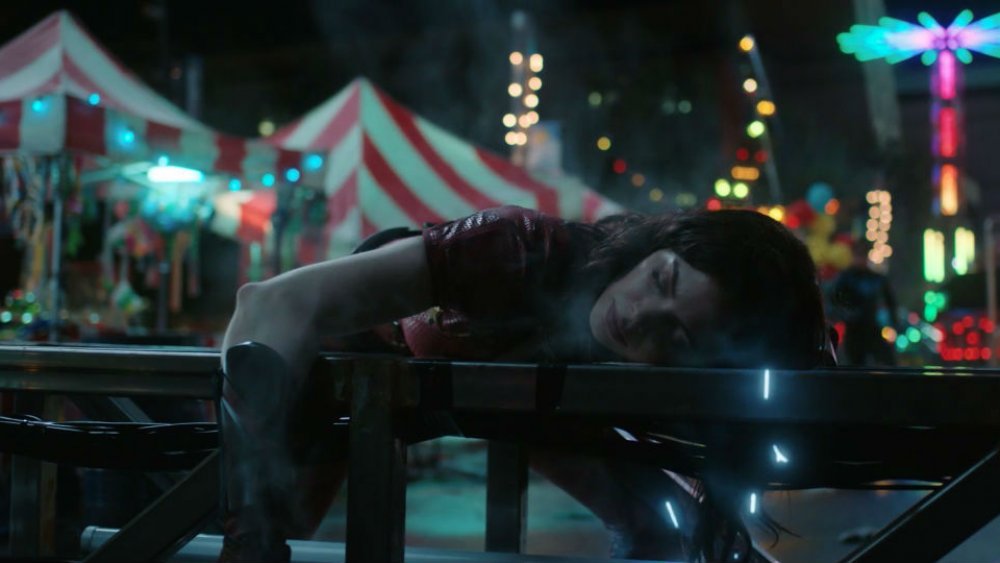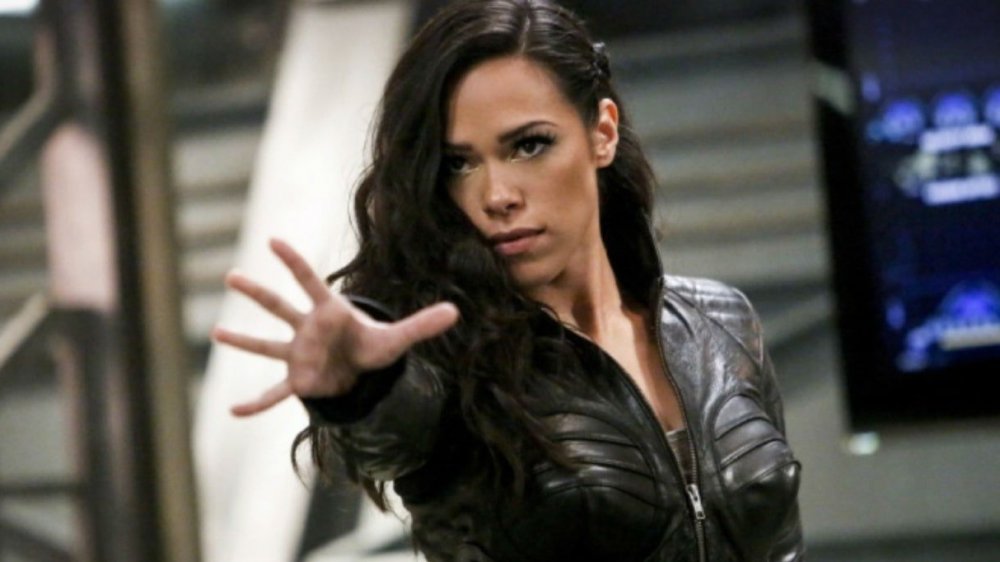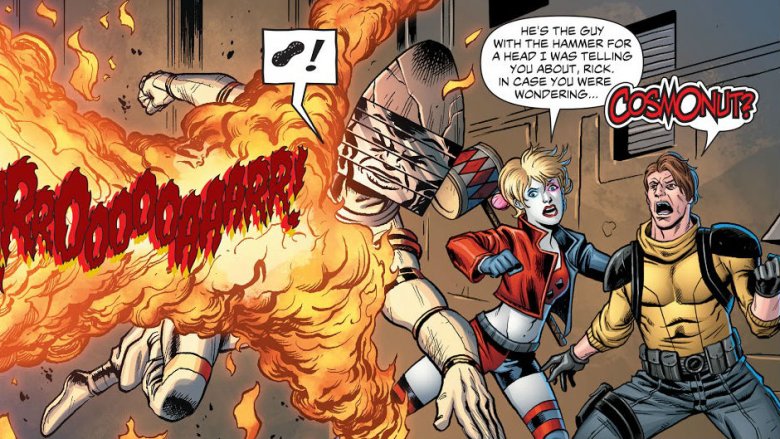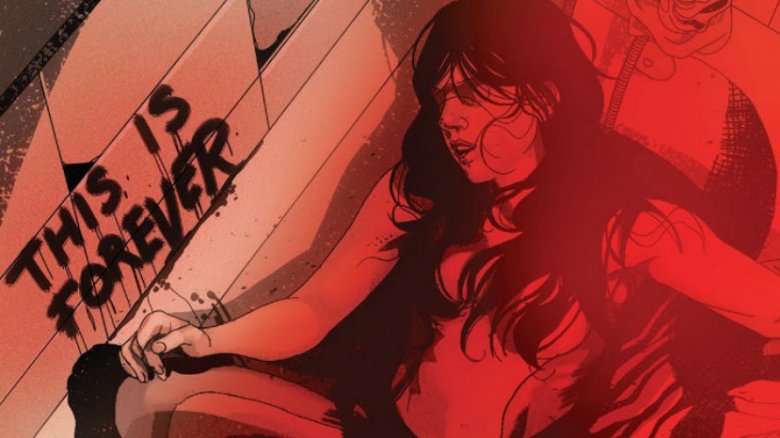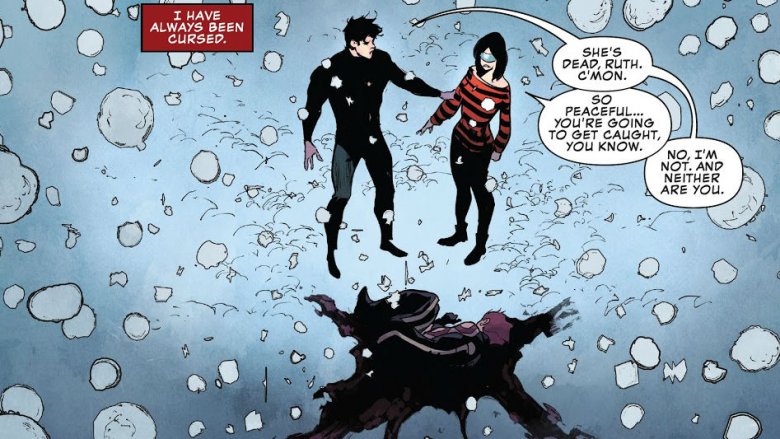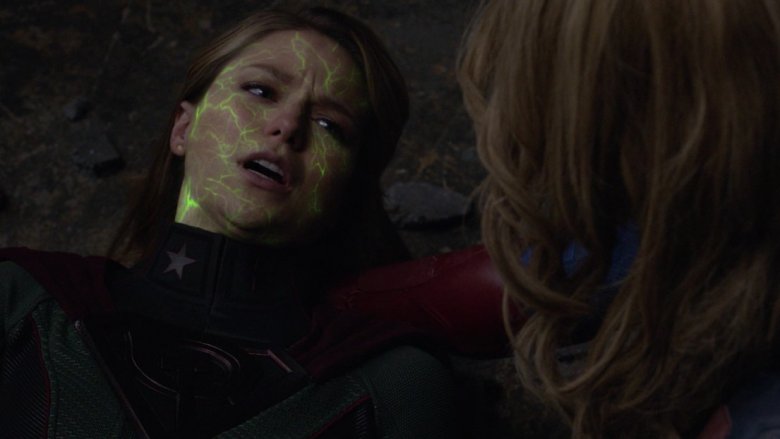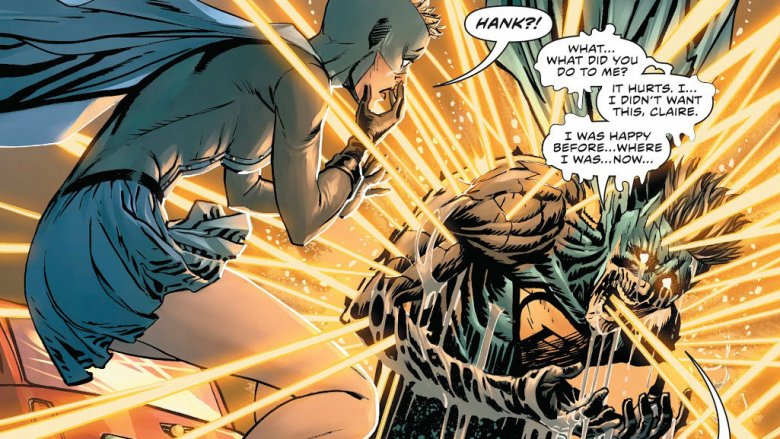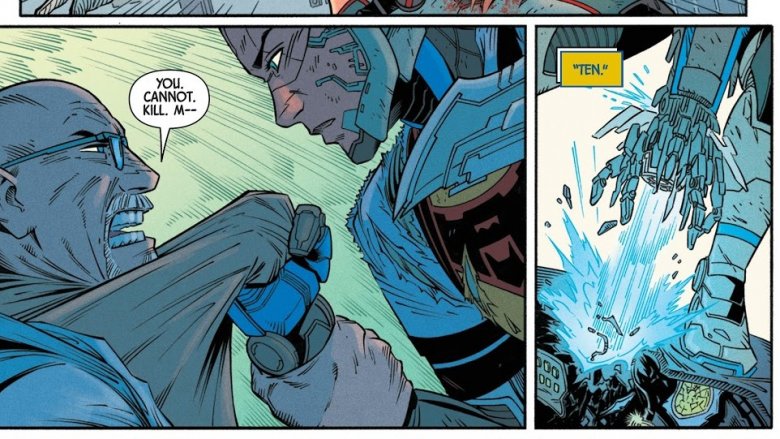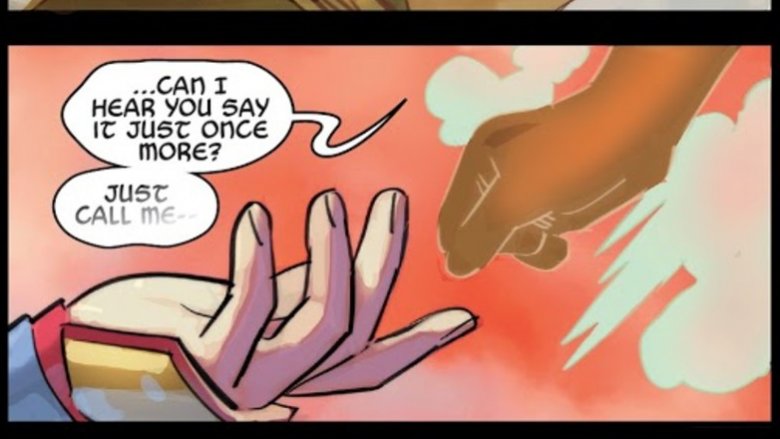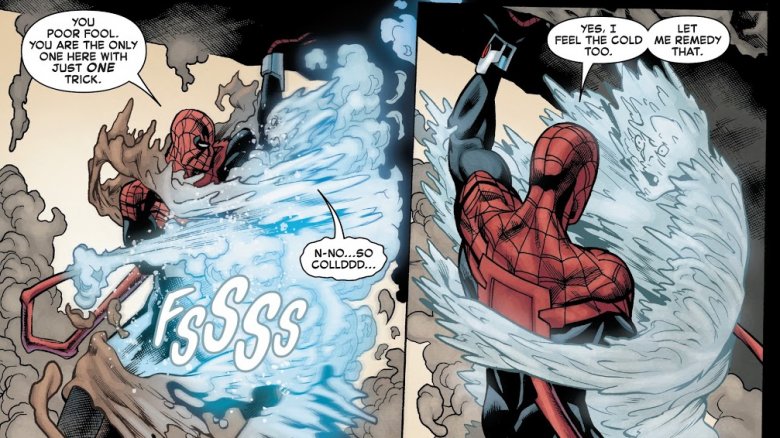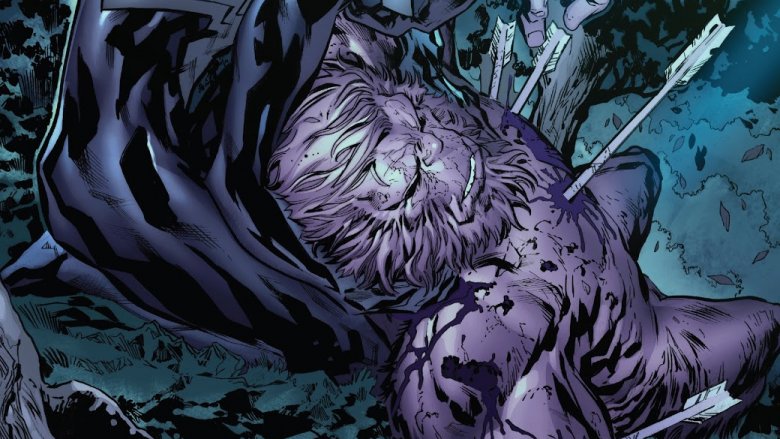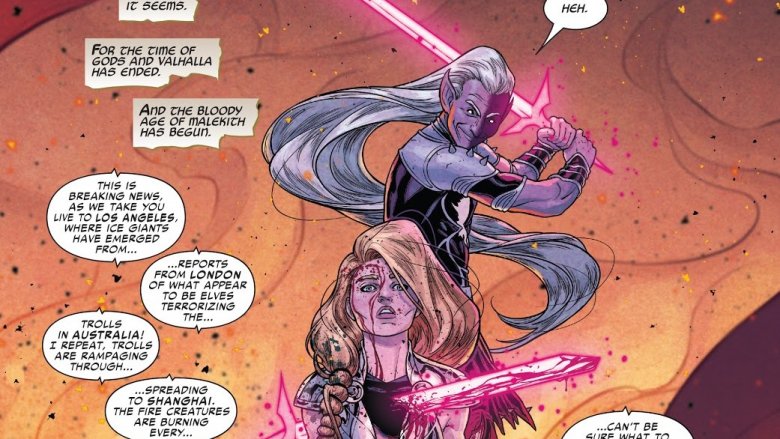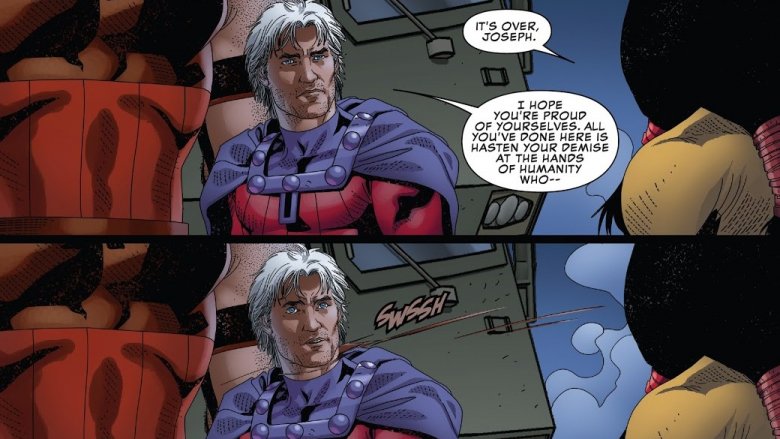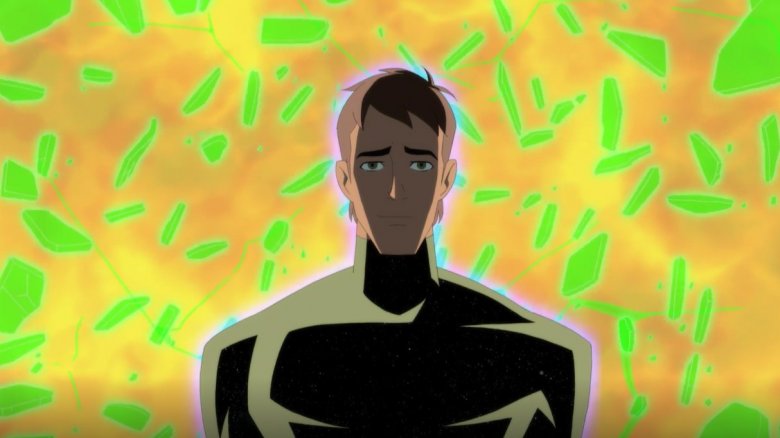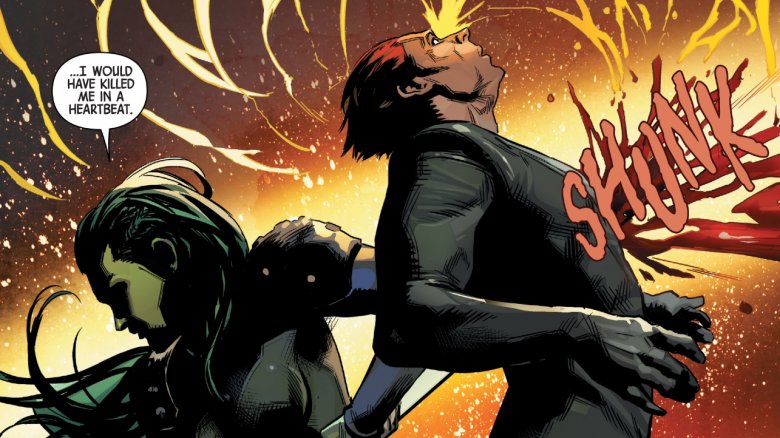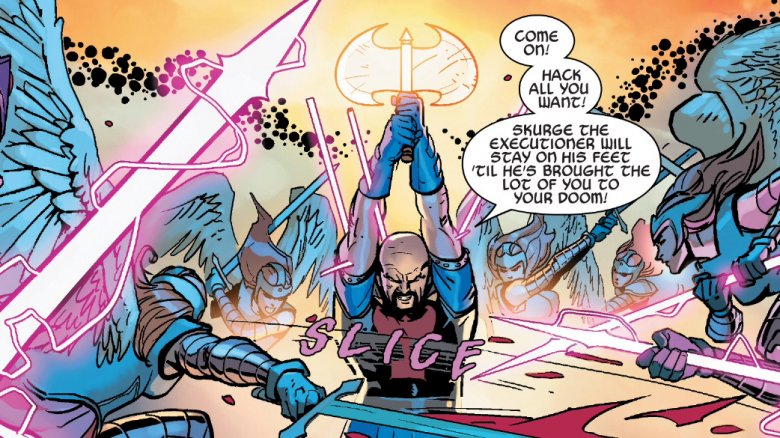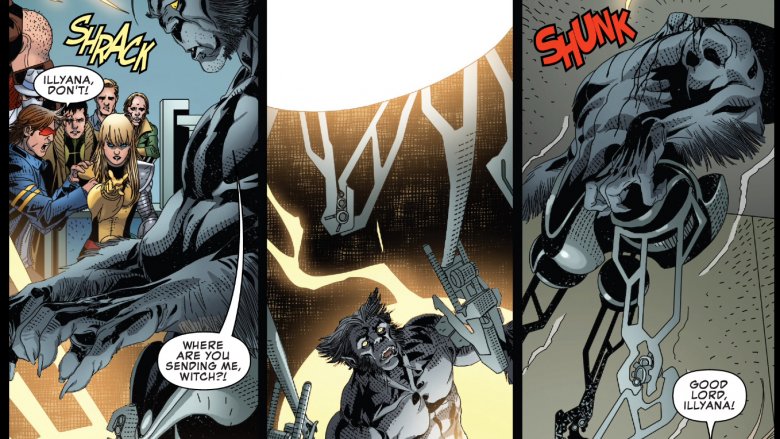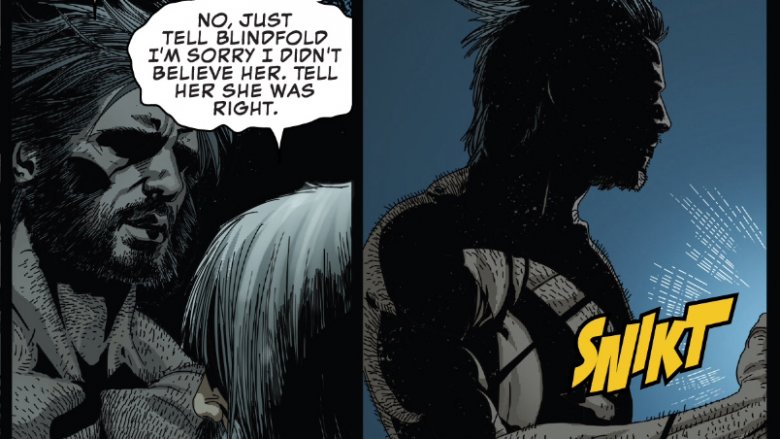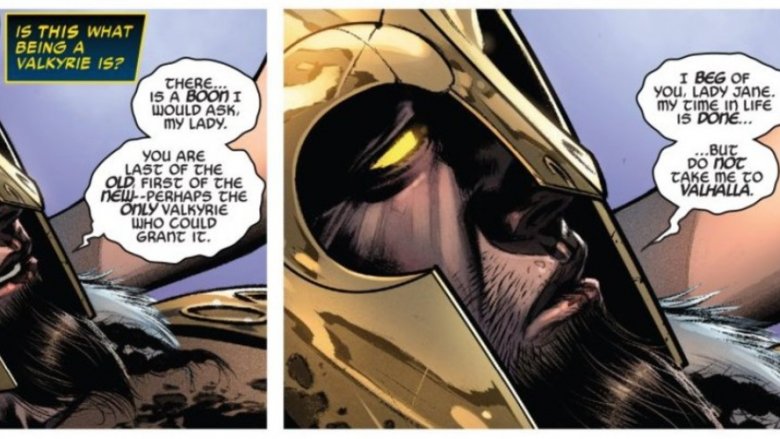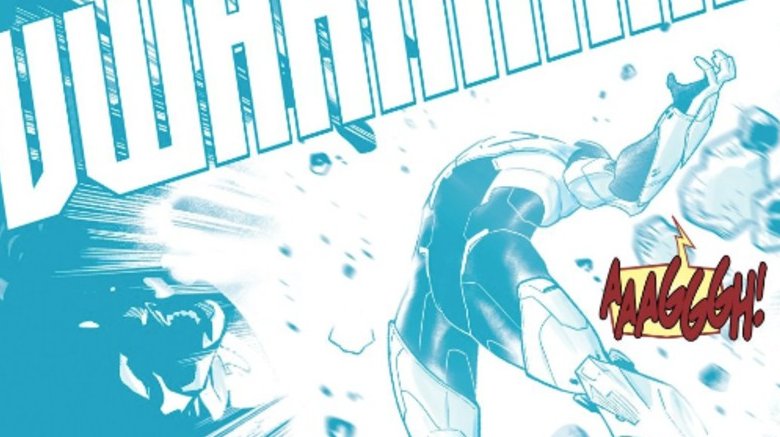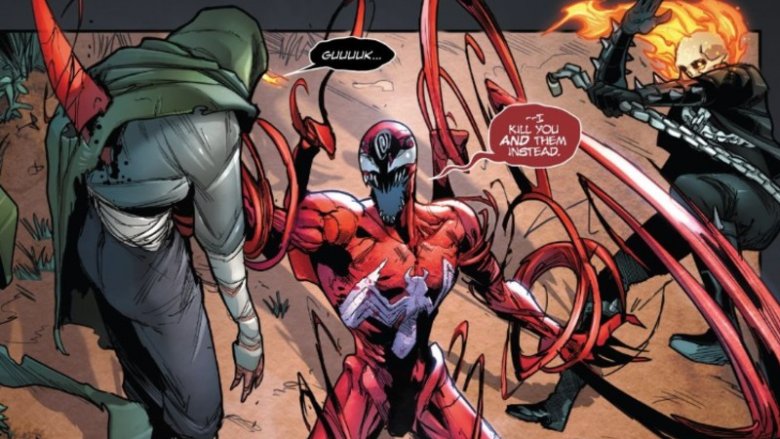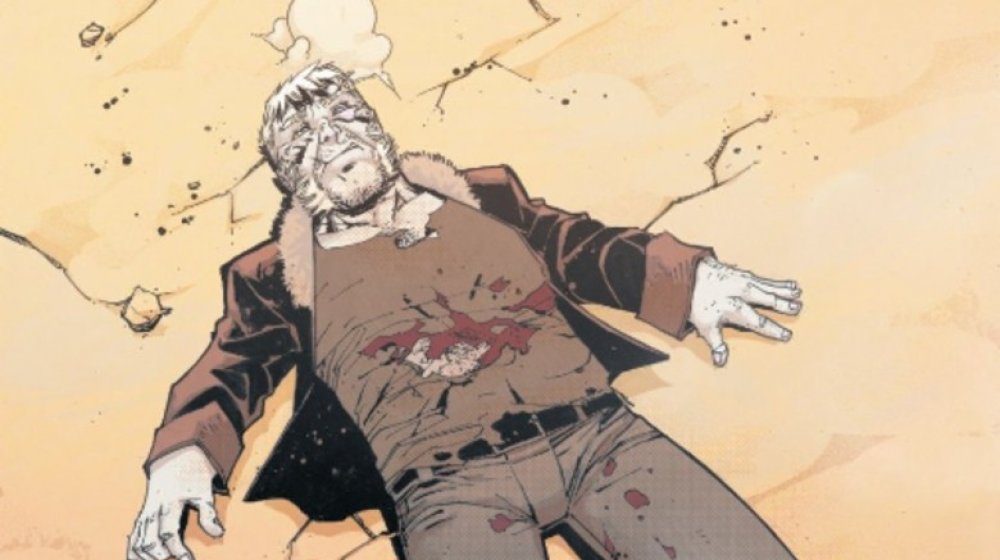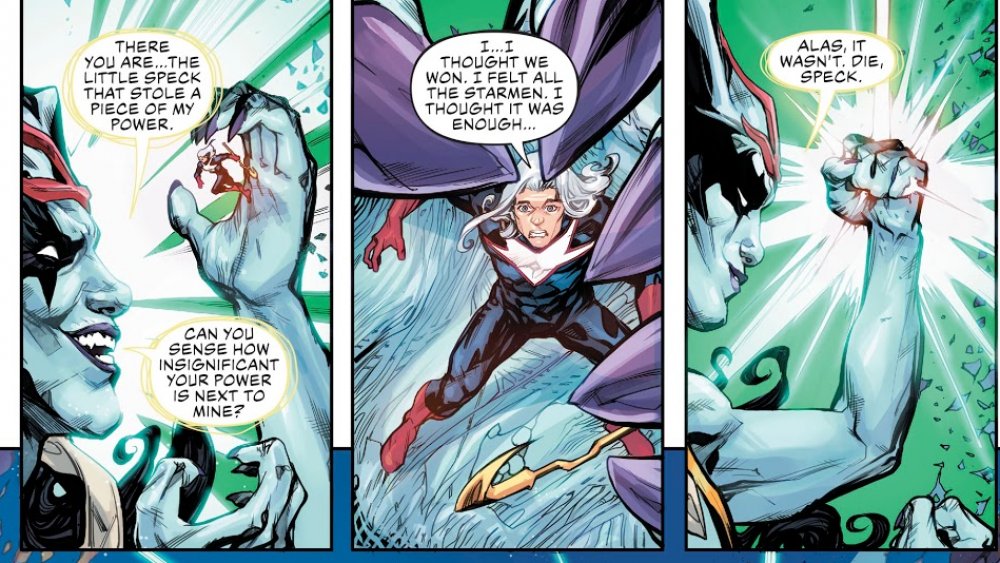Superheroes We Lost In 2019
The 2018 superhero body count was impressive, and 2019's butcher's bill promises to stack just as high, if not higher. Last year, the superhero victims didn't really give us impressive numbers until the summer with the epic kill counts of Avengers: Infinity War and Deadpool 2. Meanwhile, the ranks of the capes have already been seriously thinned in 2019.
Why the increase? Maybe it has something to do with the catastrophic Infinity War and everyone trying to copy its success. Maybe it's just that with superheroes still taking over media with no signs of slowing down, the increase in franchises will necessarily boost the numbers of the dead. Or maybe there is no mystery. Maybe it's just that the various filmmakers and comic creators know they don't have to keep any of them dead for very long anyway, so why not capitalize on the shock and drama?
Regardless of why they fell, here are all the superheroes who have fallen so far in 2019.
Black Widow (Avengers: Endgame)
The first hero to sacrifice herself in the epic Avengers: Endgame is Black Widow (Scarlett Johansson). Widow and Hawkeye (Jeremy Renner) are half of the team sent back to 2014, and the two ex-spies are assigned to get the Soul Stone. Unfortunately, though Nebula (Karen Gillan) gives the Avengers the location of the Soul Stone, she doesn't know what it will take to claim it, and so can't warn her new allies.
Widow and Hawkeye arrive on Vormir and shortly afterward encounter the Red Skull (Ross Marquand). When he explains the Stone's price, Clint and Natasha argue over who should die. Clint feels his actions as Ronin have turned him into a monster, while Nat doesn't see anything worth living for beyond the found family Thanos' purge stole from her. The argument turns physical, with Clint throwing himself over the cliff. Widow follows him and winds up dangling over a fatal drop with only Clint's grip keeping her from falling. She begs Clint to let her go, and whether he does or she simply slips, she eventually falls to her death. Just like Thanos in Infinity War, Clint wakes in a shallow pool with the Soul Stone.
It's a surprising death, particularly since we know a Black Widow film is under way. The movie is reportedly a prequel, but in the world of Marvel superheroes, you never know how temporary death might be.
Iron Man (Avengers: Endgame)
While Avengers: Endgame is by no means the end of the MCU, it made sure to let us know it was the end of an era. One signs was the death of Marvel Studios' first big-screen superhero, Iron Man (Robert Downey Jr.).
Early in the final battle, Stark asks Doctor Strange (Benedict Cumberbatch) if this was the one possible outcome Strange saw in which the good guys win. Strange refuses to answer at first. But after Thanos captures the new Infinity Gauntlet, Strange mutely signals to Tony with one index finger. Stark rushes Thanos, who easily brushes him aside. But once Thanos snaps, we learn that the point of Tony's attack was to steal the Stones. Showing the gathered Stones on his suit's gauntlet, Stark snaps his fingers and the Mad Titan's forces turn to dust. Thanos slumps to the ground and is purged from existence, just like his armies.
Tony doesn't have the strength to survive using the stones. As he struggles, Pepper summons the courage to smile and tell him they're all going to be fine, and that he can rest now. Tony dies and the light in the Arc Reactor in his chest blinks out.
While there is no post-credits scene in Endgame, there is an audio tribute to the MCU's Golden Avenger. At the end of the credits, you can hear Tony's hammer striking the anvil while making his first suit in 2008's Iron Man.
David Dunn, a.k.a. The Overseer (Glass)
Glass saw all of its super-guys killed in a single scene, good guy and bad guy alike. Unfortunately, that includes David Dunn (Bruce Willis), who had been known as the vigilante Overseer since his premiere in 2000's Unbreakable.
In the final battle between Dunn and the Beast (James McAvoy), the latter — having learned from Elijah (Samuel L. Jackson) that Dunn's weakness is water — hurls himself and Dunn into a huge plastic water tank. The tank proves too brittle for the struggle and shatters, freeing them both and flooding a large pothole.
After Dunn's son Joseph (Spencer Treat Clark) begs policemen to help his father, one of the policemen shoves Dunn's face into the pothole. Wanting him to know what's happening, Dr. Elie Staple (Sarah Paulson) rushes to Dunn and tells him to hold her hand. He does, and his power allows him to see a memory of Staple's — a meeting of a secret society dedicated to keeping people with powers in check. She tells Dunn if she'd convinced him that he never had powers, he would've been allowed to live. The policeman pushes Dunn's face back into the water, ultimately drowning him.
Dunn isn't the only victim. Elijah succumbs to wounds from an attack by the Beast, and the Beast is shot through the chest by a sniper.
Sage (The Gifted)
The 13th episode of The Gifted's second season, "teMpted," ended with Marcos, a.k.a. Eclipse (Sean Teale), killing the Inner Circle stooge Max (James Carpinello). Marcos had meant to capture and interrogate Max about the Inner Circle's plans, but Max fought back and forced Marcos to use deadly force. In the following episode, Inner Circle head Reeva (Grace Byers) searches for the traitor responsible for letting the Mutant Underground know how to find Max, and her aim proves to be as inaccurate as it is deadly.
Not knowing that Polaris (Emma Dumont) had learned to use her magnetic powers to hack computer systems, Reeva and the Frost sisters blame Sage (Hayley Lovitt), whose powers revolve around computer systems and whose digital signature they find when researching the surveillance cameras outside Max's quarters. Sage pleads her innocence, but Reeva is unconvinced. She uses her sonic powers with her usual mercilessness, murdering Sage.
Ironically, while Sage is innocent of betraying the Inner Circle in The Gifted, her comic book counterpart was a spy for Professor X, infiltrating the infamous Hellfire Club on his orders.
Reed Strucker (The Gifted)
Gifted's season 2 finale giveth and it taketh away. While "oMens" ended with the unexplained resurrection of Blink (Jamie Chung), who was presumed dead two episodes previous (at the end of "calaMity"), it also killed off one of the series' earliest regulars. Reed Strucker (Stephen Moyer) sacrificed himself to kill Inner Circle leader Reeva (Grace Byers) and stop the mutant/human war Reeva hoped to spark.
Reed had struggled with his powers ever since he learned he was a mutant in the middle of Gifted's first season. When active, Reed's powers caused anything he touched to disintegrate, which unintentionally put his own safety and that of everyone around him in jeopardy a number of times. He went so far as suppress them with drugs in the second season, but eventually — knowing the drugs would run out anyway — stopped taking them.
In the season finale, Reed used his lack of control to his advantage — or at least to the advantage of those he cared about. When the Mutant Underground raided the Inner Circle's headquarters to stop Reeva, Reed slipped past her security and confronted her on his own. Knowing Reeva's sonic powers would make his abilities even more unpredictable, Reed cut loose, utterly destroying the top floors of the Inner Circle's building as well as killing himself and Reeva in the process.
Raven, a.k.a. Mystique (Dark Phoenix)
You'd be on shaky ground calling Raven's (Jennifer Lawrence) comic book counterpart a superhero. In the comics she vacillates between villainy and moral ambiguity. But since the end of 2014's X-Men: Days of Future Past the movie franchise's Raven has been one of the good guys, and she pays dearly for that allegiance in 2019's Dark Phoenix.
Shortly after Jean Grey (Sophie Turner) leaves the mansion, we learn that Professor X (James McAvoy) not only psychically blocked Jean's traumatic childhood memories, but lied to her about the fate of her father (Scott Shepherd). He told Jean her father had died because, in truth, her father wanted nothing to do with her. Because of this, Charles knows where to look for Jean — her father's home.
Once they find her, the X-Men are no match for the emerging Phoenix. She fights them off, including injuring Quicksilver (Evan Peters) so badly he's benched for the rest of the film. When Raven tries to talk Jean down, Jean — still not fully in control of her emerging power — flings Raven back through the air. The blue-skinned mutant is impaled on a piece of wreckage and she dies gasping.
Raven's death brings with it catastrophic consequences. Magneto (Michael Fassbender) emerges to get revenge on Phoenix, Beast (Nicholas Hoult) leaves the X-Men to help Magneto, and it all puts the X-Men and Magneto's followers on an all-too-familiar collision course.
Selene Gallio, a.k.a. The Black Queen (Dark Phoenix)
Known better as the Hellfire Club's Black Queen, the comic book version of Selene Gallio (Kota Eberhardt) doesn't have even the occasional moral ambiguity Mystique enjoys — she's 100% bad guy. But the Selenes of the source material and the movie are already vastly different in terms of their abilities, and by the end of Dark Phoenix they're different in terms of their allies as well.
We first meet Selene as one of the inhabitants of the island Genosha where Magneto oversees a growing community of mutant refugees. Along with Ariki (Andrew Stehlin), Magneto brings Selene with him to New York City to kill Phoenix. She spends most of that fight using her own telepathic abilities to keep Professor X's powers busy. After all the mutants are captured by a government strike force and loaded on to a train — and that train is boarded by the D'Bari — Selene joins the X-Men against the aliens.
Unfortunately, Selene doesn't survive the battle. During a lull in the fighting she calls out to Magneto, but once Magneto turns to answer her, one of the super strong D'Bari reaches into the speeding train through an open doorway, grabs Selene, and hurls her out of the train as hard as he can. We never see her body, but since this version of the character isn't shown to have any powers beyond her telepathy, her fate seems clear.
Doctor Manhattan (HBO's Watchmen)
Watchmen's season finale ends with the death of Doctor Manhattan at the hands of Lady Trieu, though the godlike character's death doesn't get the result Trieu was hoping for.
At the end of Watchmen's seventh episode, we're met with the shocking revelation that Angela Abar's husband Cal — a relatively minor character until this point — is Doctor Manhattan in disguise. In fact, he doesn't even know he's Doctor Manhattan. In episode 8, we learn that years earlier Manhattan went to the genius Adrian Veidt to find a way to make him human. Veidt invented a device that would suppress both Manhattan's powers and his memory, allowing him to live a "normal" life. When Angela learns the white supremacist group the Kavalry has discovered her husband is actually Manhattan, she takes a hammer to his head, removing Veidt's device and warning him of the danger.
The Kavalry succeeds in capturing Manhattan, but it proves to be a trap laid by Lady Trieu. She murders the Kavalry's leaders and activates her own device designed to harness Manhattan's powers, transfer them to her, and kill Manhattan in the process. Before she can take Manhattan's powers, however, the hero manages to teleport Veidt, Looking Glass, and Julie Blake to Veidt's lair in Antarctica. Trieu succeeds in killing Manhattan, but Veidt sends a storm of his tiny squids — frozen, so they're hard as bullets — to the site, destroying Trieu's device and killing her before she can absorb Manhattan's power.
Translsucent (The Boys)
The second episode of Amazon Prime's The Boys sees the series' first superhero victim, but it's far from the last. Translucent (Alex Hassell) is captured by the Boys after he follows Hughie (Jack Quaid) from the Seven's headquarters and attacks him at his electronics store job. Hughie and Billy Butcher (Karl Urban) manage to incapacitate Translucent, but can't kill him because of his super-dense skin. Butcher brings the unconscious hero to his old colleague Frenchie (Tomer Capon), who eventually has the idea to insert a bomb into Translucent.
With Hughie still new to this outlaw life, the notion of murdering Translucent initially doesn't sit well with him. Towards the end of the second episode, he waits until he's alone with the hero and he frees him from his cage. But before Translucent can escape, Hughie changes his mind and sets off the bomb inside the supe, blowing him to smithereens.
The comic book The Boys is based on tends to be much bloodier than the show, though in this case the series handled Hughie's "christening" into Butcher's world in a much darker fashion. Like in the show, Hughie is the first member of the Boys we see killing a supe in the comic — he kills the young Blarney from the team Teenage Kix. But Blarney's death at Hughie's hands in the comic is an accident, while the Hughie of the show knows exactly what he's doing when he murders Translucent.
Popclaw (The Boys)
The accidental death of Hughie's girlfriend Robin (Jess Salgueiro) by the speedster hero A-Train (Jessie T. Usher) is what puts Hughie on his quest for justice. Before his death, Translucent reveals that A-Train was with his girlfriend Popclaw before he killed Robin. The Boys would likely have never discovered this on their own, as A-Train has been keeping his relationship with Popclaw a secret because she's seen as being something of a C-Lister in the superhero community.
The news makes Popclaw a perfect target for the Boys. Posing as workmen, they plant surveillance devices in her apartment, and when Popclaw accidentally kills her landlord, the Boys are there to blackmail her into giving them information.
When A-Train later finds out information about Compound-V (the drug he was transporting when he killed Robin) has been circulating, he forces Popclaw to go into hiding, worried that Homelander might find out about her. At the same time, A-Train correctly suspects Popclaw might be the Boys' source. When she finally admits what happened with her landlord and the Boys, A-Train uses his super speed to grab two syringes of heroin and injects them into Popclaw, a recovering addict, before she can stop him. She soon dies from the overdose.
Mesmer (The Boys)
The most brutal death we see in the first season of The Boys is that of Mesmer (Haley Joel Osment), a former teen hero who has since become obscure and been relegated to the convention circuit.
In episode 6, Frenchie and Mother's Milk (Laz Alonso) track down Mesmer at a convention and convince him to help them. In return for using his powers to read Kimiko's mind, Mother's Milk promises to reunite Mesmer with the daughter he hasn't seen in years. Butcher isn't happy when he finds out Frenchie and Mother's Milk have gone to a supe for help, and unfortunately his suspicions prove true. By the end of the sixth episode — in the hopes that it will win him favor with the Seven and bring him back to the inner circle of successful superheroes — Mesmer gives Homelander (Anthony Starr) information on all the Boys. Homelander takes Mesmer's phone containing the Boys' pictures and flies off.
Mesmer's reward never materializes... at least not the one he was hoping for. Butcher catches the psychic as he tries to flee the city and beats him to death in a public restroom — but not before he tells Mesmer to use his powers on him, so the supe can see exactly what Butcher's planning to do.
XS, a.k.a. Nora West-Allen (The Flash)
Between Avengers: Infinity War, Avengers: Endgame, and even the mid-credits scene of Ant-Man & The Wasp, Marvel might have gotten the idea that it had a monopoly on killing off characters by scrubbing them from existence. CW's The Flash begs to differ, since that's how the speedster XS — a.k.a. Nora West-Allen (Jessica Parker Kennedy) — is forced to say goodbye to her parents in the show's season 5 finale. She's erased from reality when Team Flash's defeat of the villain Cicada (Sarah Carter) changed Nora's future timeline.
In an earlier episode the heroes learn Nora has been running to and from the future, getting tips on how to beat Cicada from the imprisoned villain, the Reverse-Flash (Tom Cavanagh). In the finale Ralph Dibny (Hartley Sawyer) figures out Reverse-Flash's motivation — in the future, Cicada's dagger keeps Reverse-Flash powerless, so he wants Flash to destroy it. Regardless, the team is forced to destroy Cicada's dagger and once they do they travel to the future to stop Reverse-Flash. The heroes seem to be winning the fight, but Nora begins suffering the effects of the timeline change. Reverse-Flash tells the heroes the only way to save Nora is for her to enter his "Negative Speed Force," but she refuses — not wanting to suffer from the negative emotions necessary to access it. Reverse-Flash escapes and Nora dies embracing her mother and father, as glowing bits and pieces of her float away until she disappears.
The heroes of Earth-2 (Arrow)
As soon as the new seasons of The Flash and Arrow started up again, the "Crisis On Infinite Earths" crossover event began to loom large across the various CW shows. In the case of Arrow, the Crisis (and its universe-ending anti-matter wave) claimed its first victims as early as the premiere episode of season 8. The premiere ends with the wave wiping out Earth-2, including almost all of its superheroes. The only surviving hero of Earth-2 is that world's Laurel Lance — formerly known as both Black Canary and Black Siren — who jumps through a portal with Oliver Queen and Diggle moments before Earth-2 is wiped out.
In "Starling City," the Monitor sends Oliver Queen to Earth-2 to capture Dwarf Star particles for him. Things get complicated when Earth-2's Tommy Merlyn — eventually revealed to be that world's Dark Archer — steals the particles before Oliver can get to them. Eventually Oliver, Diggle, and Laurel are able to get the particles, but Earth-2's fate is sealed. By the episode's end, the antimatter wave has enveloped all of Starling City. We see the wave kill Oliver's mother, Rene Ramirez (a.k.a. Wild Dog), Dinah Drake (a.k.a. Black Canary), and Tommy Merlyn. While he isn't present for us to see his demise, the wave also kills Adrian Chase — Earth-2's version of the Hood.
Green Arrow (Crisis on Infinite Earths Part 1)
The long-awaited CW crossover "Crisis on Infinite Earths" finally arrived as 2019 approached its end, and the event's first chapter wasted no time in taking a major victim. Oliver Queen, a.k.a. Green Arrow, sacrifices himself in "Crisis on Infinite Earths, Part I" in order to save the population of the besieged Earth-38, home of the Arrowverse's Supergirl.
In Part 1 of Crisis, Green Arrow is one of the heroes gathered on Earth-38 to fight off the Anti-Monitor's forces and give the people of that world time to evacuate to Earth-1. When the Monitor transports the rest of the heroes away, Oliver refuses to leave even after his last arrow is depleted. By the time the Monitor finally retrieves Oliver and Earth-38 is destroyed, the Monitor tells the other heroes that Green Arrow held off the Anti-Monitor's armies long enough to save a billion people. Oliver dies soon afterward.
In Part 2 of Crisis, some of the heroes journey to Earth-18 in hopes of finding a Lazarus Pit that will bring Oliver back to life. They succeed, but only manage to revive his body. Without his soul, what the heroes resurrect is just a mindless shell. With the help of Tom Ellis' Lucifer, the heroes travel to Purgatory to get Oliver's soul, and they almost succeed. They find Oliver and are about to bring him back to the land of the living, when a man named Jim Corrigan (recognizable to comic fans as one of the hosts of the Spectre) appears and tells Oliver he is needed for another task. Oliver agrees, and Corrigan transports his friends away.
Oliver's soulless body is on the Waverider at the end of Part 3 when it, along with the rest of the multiverse, is destroyed.
Almost all the heroes of the Arrowverse (Crisis on Infinite Earths Parts 1-3)
By Part Three of the Arrowverse crossover Crisis on Infinite Earths, all the heroes of the multiverse save for the Paragons are dead. Really, just about all the people in the multiverse are dead. The only survivors are Supergirl, Batwoman, Ryan Choi, Lex Luthor, Flash, J'onn J'onzz, and Sara Lance.
Throughout Crisis we see heroes across the multiverse killed by anti-matter waves. We see Hawk and Robin of Earth-9 (home to DC Universe's Titans), the Earth-66 Robin (setting of the '60s Batman series), and Earth-203 Huntress (from Birds of Prey) all annihilated by the anti-matter wave. Oliver Queen dies fighting off the Anti-Monitor's armies, Batwoman kills the Earth-99 Batman, and Lex Luthor kills and replaces the Earth-96 Superman with the Book of Destiny. The Earth-90 Flash sacrifices himself to save Earth-1 from the anti-matter wave, which unfortunately proves futile after the Harbinger kills The Monitor.
Other than those we've already mentioned, the long list of the dead include the Earth-89 Batman (from the Burton/Schumacher films) and any members of his Bat family, the rest of the Earth-203 Birds of Prey, the Ray of Earth-X and the rest of the Freedom Fighters, the Earth-9 Titans and it's other heroes, the Mick Rory of Earth-74, the heroes of Earth-38 (Superman, Dreamer, Brainiac, and Guardian), the heroes of Earth-1 (Vibe, Killer Frost, Elongated Man, Spartan, Arsenal, Mr. Terrific, Ragman, Wild Dog, and all the Legends except Sara Lance), Black Canary of Earth-2, the former Superman and other heroes of Earth-167 (home to Smallville), Black Lightning, Thunder, Lightning, Jonah Hex, and Pariah.
Aqualad (Titans)
If you've been following Titans' second season, then you know something has been brewing with the team regarding a past conflict with the mercenary Deathstroke. In the second season's fourth episode, "Aqualad," we finally get a glimpse at the beginning of the clash as Garth, a.k.a. Aqualad, is murdered at the end of the episode bearing his name.
Throughout the episode, Aqualad tries to woo Donna Troy, and it's clear he's had a thing for her for years. They finally sleep together toward the end of the episode, but it's only hours before Donna Troy plans to secretly leave Titans Tower for Themyscira. Once Dick Grayson tells Aqualad what Donna's planning, Aqualad finds Donna at the airport to profess his love and, he hopes, stop her from leaving. He catches Donna and her older mentor Jillian before they get on the plane, and things look hopeful for their young love before Deathstroke fires from a hidden position. Garth turns and protects Donna from the bullet, taking it in the chest and dying. Donna and Jillian manage to escape, and by the end of the episode Donna and the rest of the Titans are ready to exact some vengeance.
As of the end of the fourth episode, it isn't clear who Deathstroke's real target was. He continues to fire after Garth falls, and Slade isn't usually portrayed as the kind of guy who kills for free unless he has no other choice.
Donna Troy (Titans)
Titans' second season ends with Deathstroke's defeat and the liberation of both Beast Boy and Superboy from Cadmus's mental conditioning, but the team's victories come at a high cost. One of the original Titans, Donna Troy, sacrifices herself to save innocents and one of her teammates.
The Titans' battle with Superboy takes place in an amusement park, and after both Conner and Gar have been freed from Cadmus' influence, Dove retrieves a doll from a ride for a little girl. As she's returning the doll a metal tower, damaged from the fight, groans and falls towards Dove and the little girl. Donna Troy characteristically charges in and holds the tower aloft long enough for Dove and the endangered civilians to escape. Unfortunately, the tower is coursing with power which electrocutes Donna and finally kills her. Once Dove and the civilians are clear, Donna drops the tower and collapses on top of it, dead.
Considering that Donna is one of the most physically powerful members of the Titans before her death — she's the only one able to trade punches with an unrestrained Superboy — it's surprising this injury kills her. It's possible the stress from fighting Superboy is what weakens her to the point that the shock from the tower proves fatal.
It's possible Donna could return. Intrigued with her emerging healing powers, Rachel joins the Themyscirans when they take Donna's body back home, hopeful she can find a way to revive her teammate.
Gypsy (The Flash)
In the fifth episode of The Flash's sixth season, "Kiss Kiss Breach Breach," Cisco's old flame Gypsy returns to Earth-1, but sadly she does so only to die off-screen at the hands of her longtime adversary, Echo.
When we first met Gypsy back in season 3, we learned that she was from Earth-19, where she acted as an official "collector." On her Earth, the existence of the Multiverse is common knowledge, but travel between parallel Earths is banned. If you're from Earth-19 and you travel between alternate Earths, a collector like Gypsy or her more brutal father Breacher comes after you. Cisco and Gypsy dated for a while, but they broke up in season 4.
Since we first met her Gypsy's had an arch-nemesis — a criminal known only as Echo who, before her death, Gypsy had never even seen. In their final battle, Gypsy uses her powers to transport herself and Echo to Earth-1, where Echo vaporizes and kills her. Echo, we eventually learn, is the Earth-19 version of Cisco, who tries to frame his Earth-1 alternate for the murder. Breacher and the rest of the collectors are initially fooled, but eventually Cisco-prime finds Echo, unveils his plot, and avenges Gypsy's murder.
Cosmonut (Suicide Squad #50)
First appearing back in 2016's Suicide Squad #3, the bizarre Cosmonut was a member of Russia's Annihilation Brigade. The Brigade tried and failed to stop the Squad from escaping after they broke into the underground Temho-Metya Prison. But in the recent Suicide Squad #50, Cosmonut sacrificed himself for his old adversaries.
With the usually very non-super Amanda Waller rendered a giant, super-strong, mindless beast that could breathe fire, Harley Quinn and Rick Flagg were not much of a match for their boss. In a move uncharacteristic of any member of the Annihilation Brigade, Cosmonut saved his old enemies by holding off Waller. Quinn and Flagg eventually managed to find the rest of the Squad — including Killer Croc, who'd been presumed dead the since the previous issue — and restore Waller to a less Godzilla-esque form, but not in time to save Cosmonut. Before losing her powers, Waller melted his big metal hammer head.
In true Suicide Squad fashion, none of the Squadders memorialized poor Cosmonut's sacrifice, or even seemed to remember he was there.
Blindfold (Uncanny X-Men #11)
February's Uncanny X-Men #11 was noteworthy for a number of reasons. The one most heavily promoted by Marvel was that it represented the first reunion of the newly resurrected Wolverine and Cyclops. But while it gave the X-Men back two of their favorite sons, it also stole away two of their lesser-known daughters.
The first victim of Uncanny X-Men #11 (at least, the first one we see) was the young future-seeing Ruth, a.k.a. Blindfold. In the wake of almost all of the X-Men disappearing in previous issues, Blindfold was one of the few allies both Wolverine and Cyclops were able to contact while looking for survivors. Unfortunately, Ruth was suffering from bleak and disturbing images of the future. Uncanny X-Men #11 was split into three sections, with the first two telling the story from the points of view of Cyclops and Wolverine respectively, while the last was reserved for Blindfold. Her chapter is a purposely confusing and blurry part of the story, with the only clear thing being that Blindfold feels utterly hopeless facing what's to come. And so, in the first chapter, Scott Summers finds Ruth has committed suicide in her bathtub, cryptically writing "This is forever" on the wall in her own blood.
Ruth first entered the X-Men mythos courtesy of Buffy the Vampire Slayer creator Joss Whedon and artist John Cassaday's game-changing Astonishing X-Men run, when Ruth — ironically, considering her end — predicted the tragic suicide of fellow Xavier student Wing.
Loa (Uncanny X-Men #11)
The timeline of Uncanny X-Men #11 isn't a straight line. While Blindfold is the first mutant hero we see die in the issue, chronologically speaking the C-Lister Loa dies before her.
It's a strange portrayal of a death, particularly for a superhero character, in that we see little of the events leading up to it and don't even know who killed Loa or how. Held hostage by Blindfold's random "memory" of what has happened, what is happening, and what's to come (Watchmen readers will likely be reminded of the screwy, random order in which Doctor Manhattan tells the story of his life), we find Velocidad and Blindfold standing over the corpse of Loa in the snow. We don't know exactly how she died or exactly who killed her.
Considering the events of the rest of Uncanny X-Men #11, which shows how anti-mutant groups like the Purifiers feel like happy ants at a picnic in the wake of the X-Men's disappearance, it seems likely some kind of mutant-hating group was responsible for Loa's death, but we don't know for sure. The feel of the issue, particularly Blindfold's chapter, suggests our confusion will be cleared up in the near future.
Red Daughter (Supergirl)
As far as we know, Melissa Benoist will continue playing Supergirl, but season 5 of Supergirl will see her playing one less character. Season 4 had Benoist doing double duty (or triple, if you count Supergirl's alter ego Kara Danvers) as both Supergirl and a clone raised in the fictional Eastern European nation of Kaznia. The clone was initially referred to as Snowbird and later nicknamed Red Daughter, referring to the classic DC Elseworlds miniseries Superman: Red Son, which had Kal-El raised in the Soviet Union rather than Kansas.
Lex Luthor (Jon Cryer) allies himself with the Kaznians and uses the opportunity to manipulate Red Daughter and make her utterly loyal to him. Unfortunately, in Supergirl's season 4 finale Red Daughter learns that loyalty only goes one way. Lex fools the Kaznians into believing he's supporting an invasion of the United States, when in fact he uses the opportunity to destroy the invading Kaznians and falsely prove himself as a hero to the U.S.
When Supergirl confronts Luthor with what he's done, she ultimately needs Red Daughter's help. The clone dies saving Supergirl from Lex. She gets in between Lex and Supergirl when Lex tries to blast the hero with Kryptonite energy. The Kryptonite kills Red Daughter, but as she dies she releases energy that Supergirl is able to use to grow stronger and defeat Luthor.
Gotham (Batman #65)
Neither mutants nor Marvel have a monopoly on superhero deaths, and this year's first DC Comics superhero death happened as a part of the mini-event "The Price." Told in alternating issues of Batman and The Flash, "The Price" acts as an offshoot of the mini-series Heroes in Crisis.
Early in the current run of Batman, the Caped Crusader came across two heroes he thought might act as replacements in his mission to safeguard Gotham. The brother/sister team of Gotham and Gotham Girl idolized Batman while at the same time displaying powers similar to Superman. Batman ultimately learned the pair were too good to be true. They'd subjected themselves to experiments to gain their powers, and those powers were slowly killing them. Gotham (the dude, not the city) died and Batman did what he could to help Gotham Girl. But in "The Price," Gotham Girl returns with a plan for vengeance, a mystery benefactor, and her brother resurrected.
Gotham's return is short-lived. In battle with the Flash, Gotham quickly overextends himself and again dies, literally exploding. We'll learn soon if his sister will join him in the void this time around, or if Batman will try once more to rehabilitate her.
Scout, a.k.a. X-Assassin (X-23 #10)
Ever since the 2018 premiere of the most recent volume of X-23 – the title starring Laura Kinney, the young female clone of Wolverine — Laura's sister/clone Gabby, a.k.a. Honey Badger, has been a regular fixture. For a few months it looked like a third sister might join the sorority of claw-happy sister-clones: In X-23 #7, Laura was attacked by a cybernetic assassin who ultimately proved to be another clone of Laura.
Laura learned that her creator, Dr. Robert Chandler, was producing an army of cybernetic X-23 clones for the company Med-X-Tronics. Unlike Laura or Gabby, the cyborg clones' healing powers were compromised. While Laura investigated, Gabby spent as much time as she could with her new "sister," who said nothing, seemed almost comatose, and whose only name was the one Dr. Chandler gave her: "X-Assassin."
When Laura was pinned down at Med-X-Tronics by dozens of her cybernetic clones, Gabby and X-Assassin came to the rescue. As Dr. Chandler tried to escape in a helicopter, X-Assassin directed Gabby to hit a button when the time was right. The cyborg clone boarded the helicopter, threw Laura free from it, and Gabby hit the button — causing X-Assassin to explode and killing Dr. Chandler along with her.
The issue ends with Gabby mourning the loss of the sister she barely got to know. Based on an undefined anagram on her chest — T.U.O.K.S. — Gabby wrote down her choice for her departed sister's name: "Scout."
Kid Loki (Asgardians of the Galaxy #7)
While Marvel had a lot of reboots in 2018, one of its completely new series – Asgardians of the Galaxy – has proven to be one of the most fun. With a team of Asgardian and Asgardian-themed heroes forming to stop Nebula from bringing about universal Ragnarok, the Asgardians are led by the deadly Angela and their roster includes Skurge the Executioner, Valkyrie, Thunderstrike and Throg, Frog of Thunder (Thor, if Thor was a frog — no, really).
The team also included the deadly Destroyer armor, and by the end of the first issue it was revealed that the armor was hiding and protecting Kid Loki, a younger and even more insufferable version who emerged as a result of the original Loki's death in the 2010 line-wide event Siege. However, since then an adult Loki has also come to exist in the Marvel Universe.
There is some mystery behind how Kid Loki dies in Asgardians of the Galaxy #7, because it isn't a result of that issue's events. Angela finds Kid Loki lounging on the branch of a tree. He tells her he can't go with her because his older counterpart has dismissed the spell that brought him into being. Kid Loki simply vanishes into nothing.
Waxman (Superior Spider-Man #4)
While he wasn't exactly an angel, Waxman was working on their side for a bit. Along with the rest of the San Francisco-based group Night Shift, Waxman was recruited by Otto Octavius, a.k.a. the "Superior" Spider-Man, to help him fight crime in the City by the Bay.
After an explosive two-issue clash between Superior Spidey and the former Herald of Galactus, Terrax the Tamer, a neighborhood in downtown San Francisco is left in ruins in Superior Spider-Man #4. Otto initially plans to skedaddle and let the civilian authorities handle the cleanup, but a guilt trip from colleague and former lover Anna Maria Marconi puts Superior Spider-Man back on the job. Wrangling the Night Shift and deploying his Spider-Bots, Otto looks for survivors in the building rubble. He detects one and sends Waxman — whose malleable body allows him to squeeze through cracks in the rubble – to calm the survivors and let them know help is on the way.
Meanwhile, highly suspicious of Night Shift, Marconi discovers Waxman is a serial killer and relays this information to Otto. Octavius rushes through the rubble and finds Waxman looming over the survivor — a young boy — about to kill him. Superior Spidey and Waxman battle briefly, ending with Spidey freezing Waxman's body and shattering it into pieces with his fist.
Gibbon (Amazing Spider-Man #18.HU)
War of the Realms is only one of Marvel Comics' 2019 events. This year's Spidey event, Hunted, just kicked off and it's already claimed a handful of victims. So far, the only casualty to have any kind of superhero background is Martin Blank, a.k.a. the Gibbon.
When Kraven the Hunter gathers all the animal-themed Marvel heroes and villains he can to be hunted by Kraven drones (each controlled by a different super-rich client), Gibbon is one of the many hostages that becomes prey. in Amazing Spider-Man #18, when Gibbon faces the choice to follow either Spider-Man or Vulture, Gibbon's antagonistic past with Spidey makes him choose Vulture. Unfortunately, surprising no one but Gibbon, Vulture uses the lesser-known villain as a shield against Kraven's drones. In Amazing Spider-Man #18.HU, after narrating the sad moments leading up to his end in Hunted, we watch Gibbon succumb to his pursuers' attacks. He dies in Spider-Man's arms.
Gibbon started his Marvel life as a villain in 1972's Amazing Spider-Man #110. When, while wearing a gibbon suit, he asks to be Spider-Man's partner, Spidey laughs at the idea. Already a victim of constant bullying and cruel laughter, Gibbon lashes out and becomes Spider-Man's enemy. He popped up here and there over the years, and would eventually become the hero of the 2008/2009 mini-series Marvel Apes when he was transported to an alternate reality where apes, monkeys, chimpanzees and the like are the dominant Earth species.
Valkyrie (War of the Realms #2)
War of the Realms continues to rage through the Marvel Universe. In War of the Realms #2, Asgard loses one of its favorite daughters — Valkyrie. Fighting atop a pile of slain trolls and dark elves, Valkyrie calls out to Malekith, architect of the War of the Realms, to stop hiding and face her. Malekith surprises her and stabs her from behind, and the issue ends with the dark elf mercilessly beheading her.
While this seems as conclusive an end to a character as you'll get in a Marvel comic, Malekith does not kill Marvel's last Valkyrie. Three weeks before the release of War of the Realms #2, Marvel's Editor-in-Chief CB Cebulski announced at Chicago's C2E2 that a new Valkyrie comic would spin out of War of the Realms. Once fans learned of Valkyrie's violent end in War of the Realms #2, Marvel didn't wait long to end their confusion. The day after the comic's release, news broke that it would not be Brunnhilde — the Valkyrie who dies in War of the Realms — in the new Valkyrie series, but Jane Foster. Foster is played by Natalie Portman in the MCU films, and in the comics took over the mantle of Thor for four years, until being forced to sacrifice Mjolnir in order to stop the monstrous Mangog in 2018's Mighty Thor #705.
Joseph (Uncanny X-Men #16)
In Uncanny X-Men #16, the X-Men respond when the Brotherhood attacks an Air Force Base in Transia. The Brotherhood appear to be led by Magneto, but this proves to be a ruse. When the Brotherhood leader's helmet is knocked off, Karma scans his mind and discovers his true identity. He is Joseph: a clone of Magneto who joined the X-Men in the mid-'90s. Joseph reveals that in the wake of what many believe to be the death of most of the X-men, including the real Magneto, he took up the mantle in order to wage war on humanity.
Joseph seems to have the X-Men beaten, but the rest of the Brotherhood doesn't appreciate being fooled. Juggernaut and Pyro attack the clone, but the X-Men break up the fight. Joseph is in the middle of trying to convince the X-Men that capturing him is a mistake when an almost imperceptible sword slice cuts through his neck and stops him mid-sentence. In the following panel, we see his head fall to the ground while the rest of his body remains upright.
The attacker is Kwannon — a telekinetic ninja recently resurrected in the mini-series Hunt For Wolverine: Mystery in Madripoor. We don't get much of a reason for Kwannon's attack. She tells Wolverine someone was using Joseph as a weapon "to erase mutants from the Earth." There's no chance to get into specifics, because Mirage suddenly collapses, announcing that she senses an absent X-Man has died.
Star Boy (Justice League Vs. The Fatal Five)
In Justice League Vs. The Fatal Five, the Fatal Five are criminals from the future. Thomas Kallor, a.k.a. Star Boy (Elyes Gabel) of the 31st century Legion of Super-Heroes, follows them into the past and allies himself with the Justice League. When the Fatal Five detonate a Green Lantern-powered bomb in the Earth's sun — thereby, they hope, destroying the Earth and preventing the Legion of Super-Heroes from existing — Star Boy uses his mass-controlling powers to stop their plan. Unfortunately the only way for the hero to save the sun is from its interior, so saving the Earth means dooming himself.
The animated film tackles the subject of living with mental illness through Star Boy and the Green Lantern Jessica Cruz (Diane Guerrero). When we meet Green Lantern, she suffers from crippling survivor's guilt after barely escaping a murderer who kills her friends. When Star Boy arrives in the 21st century, he's arrested and sent to Arkham Asylum. We learn he's schizophrenic and the medicine he uses to treat his condition in the 31st century isn't available in our time. No one believes his stories about being a superhero and he docilely accepts his incarceration until a news report about the Fatal Five triggers him. When he sacrifices himself at the end of the film, Green Lantern begs him to not do it and yells "Thomas!" Star Boy's final words are "It's Star Boy. I'm a superhero."
Starfox (Guardians of the Galaxy #6)
The current volume of Guardians of the Galaxy spins out of the line-wide event Infinity Wars in which Gamora murders her adoptive father Thanos. In Guardians of the Galaxy #1 we learn Thanos had arranged to have his consciousness uploaded into someone else's body in the case of his untimely death. Starfox — Thanos' brother — assembles a team of "Dark Guardians" to find and kill the most likely candidates, starting with Gamora, while Peter Quill's Guardians try to save her. Unfortunately for Starfox and his Dark Guardians, it turns out Gamora isn't the most likely candidate after all.
In Guardians of the Galaxy #5 we find out it was Starfox into whom Thanos' consciousness was uploaded, and it was the Asgardian goddess of death, Hela, who did the deed. After the Dark Guardians capture Gamora, Hela appears and easily brushes them aside. She convinces Starfox of the truth and Thanos' consciousness emerges and gains dominance over his brother's body. Hela brings Starfox to Knowhere, where Thanos' reassembled body awaits. The Guardians arrive on Knowhere, and Gamora runs Starfox through — killing him and stopping the transfer of Thanos' consciousness into his new body.
Skurge the Executioner (Asgardians of the Galaxy #10)
With the deaths of Kid Loki and Valkyrie, the Asgardians of the Galaxy arguably suffer more than any other superhero team in Marvel's War of the Realms event. Asgardians of the Galaxy #10, the series finale, takes one more victim from the Asgardians' ranks, as Skurge the Executioner makes a last stand brimming with dark irony.
Skurge was freshly resurrected when he joined the Asgardians of the Galaxy, and his previous death was one of the most memorable in Marvel Comics history. He died in the 1985 classic Thor #362, fighting off waves of undead soldiers to give his Asgardian brethren time to escape Hel. This time around, Skurge's foes are much different. The angels of Heven inexplicably side with the Dark Elf Malekith in War of the Realms, and Skurge dies fighting them.
Skurge joins Angela in Heven itself, and once there Skurge holds off the angels to give Angela the time to summon an army of undead Asgardian warriors team encountered earlier in the series. Ironically, Skurge dies his first death against an army of the dead, and dies his second death helping to summon another army of the dead to his side.
After he succumbs to his wounds, Skurge awakes in Valhalla, the realm of the honored dead. Valhalla's other residents greet him warmly, and when he insists that he hasn't earned a place among them, they tell him they all thought the same thing when they got there.
Dark Beast (Uncanny X-Men #20)
Dark Beast — a version of Hank McCoy from an alternate reality based on the 1995 Age of Apocalypse event — wasn't much of a superhero. Nevertheless, he's been working with the X-Men since Cyclops returned from the dead and started putting a new team together in Uncanny X-Men #11. In Uncanny X-Men #20, Dark Beast finally turns on his benefactors, thinking he's helping them, and pays for his mistake with his life.
All across the globe, parents are giving their children a new vaccine designed to suppress any emerging mutant genes. Dark Beast tells his teammates he's figured out a way to counteract the vaccine. He just needs his own agent dispersed in the upper atmosphere. Unfortunately, the X-Men trust Dark Beast, and Banshee disperses the agent as ordered.
The X-Men inevitably learn that Dark Beast failed to tell them that, once his agent had been dispersed, it wouldn't simply stop the anti-mutant vaccine from working; if a child receiving the vaccine is a mutant, it will likely kill them. Dark Beast sees this as an inestimable success, saying that now human parents won't dare get their children vaccinated. Ignoring Cyclops' protests, the vengeful Magik uses her mutant power to teleport Dark Beast's head into the ceiling, ending his experiments permanently.
Velocidad (Uncanny X-Men #21)
We last saw Gabriel Cohuelo, a.k.a. Velocidad, in Uncanny X-Men #11. While initially a younger hero, Velocidad had been forced to use his powers so much that he aged prematurely. Shortly before her death in that issue, Blindfold had warned Velocidad he was going to get caught. In Uncanny X-Men #21 we learn she was right, but Logan makes sure he doesn't stay caught for long.
As part of the military's program to merge captured mutants with techno-organic viruses, Velocidad has been one of the O*N*E program's most important assets. Velocidad tells Logan they've been forcing him to use his time-manipulation abilities to mature the techno-organics that much quicker. Wolverine offers to rescue Velocidad and get him help, but the dying hero tells Logan he won't survive and — not knowing she's already dead — asks Logan to tell Blindfold she was right. Sparing him the news of his friend's suicide, Logan agrees and puts Velocidad out of his misery with his claws.
Heimdall (Valkyrie: Jane Foster #2)
Last year, the Heimdall of the MCU (Idris Elba) died at Thanos' hands in the opening scene of Avengers: Infinity War. In Valkyrie: Jane Foster #2, Heimdall's comic book counterpart dies as well, though the villain who kills him isn't quite as powerful.
The line-wide Marvel Comics event War of the Realms is over, but the shockwaves are still being felt. Jane Foster replaces the late Brunnhilde as Valkyrie at the end of the event, launching her new solo series Valkyrie: Jane Foster. In the first issue, Foster defeats some minor villains who stole the original Valkyrie's sword after her death, but one of them gets away. The sword, Dragonfang, is claimed by the psychotic Daredevil villain Bullseye. As the issue ends, Bullseye runs Heimdall through with Dragonfang from behind.
Heimdall initially survives and helps Foster battle the villain. In Valkyrie: Jane Foster #2, Foster defeats Bullseye and destroys Dragonfang, but Heimdall sadly dies from his wounds. As he dies, he begs Foster to not take him to Valhalla, the Asgardian home of the honored warrior dead, but to bring him beyond the ten realms so he can see what is there. Foster agrees, promising to embark on a "Journey Into Mystery" with the late bridge-keeper, echoing the title of the comic in which Marvel's Thor first appeared in 1962.
Tony Stark, A.I. (Tony Stark: Iron Man #15)
Tony Stark: Iron Man #15 sees the return of an old friend: an artificial intelligence version of Tony Stark. The Stark A.I. became active after the events Civil War II left Tony in a coma. It acted as mentor to Riri WIlliams, a.k.a. Ironheart, and occupied one of Tony's suits to help his friends against Hydra in the company-wide Secret Empire event.
The real Stark is being interviewed by Congress in Tony Stark: Iron Man #15, and one of the senators has somehow gotten his hands on the Stark A.I. He reactivates it in the middle of the proceedings, and when Iron Man is attacked by a bizarre android comprised of the fused bodies of Vision and Wonder Man, the A.I. is there to help him. Unfortunately, Tony knows the only thing that will stop the android is an EMP cascade, which he knows will also kill the A.I. The Stark A.I. tells him to go through with it anyway, sacrificing itself.
Since the beginning of Tony Stark: Iron Man, Tony and his colleagues have been dealing with the notion of whether or not beings of artificial intelligence deserve the same rights as humans. While Stark is testifying, there are robots protesting in the street, and his EMP cascade kills all of them as well.
Alejandra Jones, a.k.a. Ghost Rider (Absolute Carnage: Symbiote of Vengeance #1)
War of the Realms may be over, but the line-wide Marvel event Absolute Carnage has just begun. The ruthless Carnage is tearing through the Marvel Universe, looking for any human who has ever bonded with a symbiote. Within each would-be victim is a biological codex attached to the spine, and once Carnage collects all of them, he believes he will become a god. In the one-shot Absolute Carnage: Symbiote of Vengeance #1, Carnage takes one of his first super-powered victims: Alejandra Jones, one of the lesser known Ghost Riders.
Jones was taken under the wing of the Ghost Rider Johnny Blaze in his 2011-2012 solo series. In the beginning of Symbiote of Vengeance #1, we learn that she now guards a village in Nicaragua against gangs and militias. That's where Carnage finds her, and that's where Johnny Blaze — the current King of Hell — sends the Ghost Rider Danny Ketch to save Jones. Unfortunately, Ketch fails when Carnage runs Jones through with a spiked limb.
When Jones awakens in Hell (the afterlife home of any Ghost Rider), she convinces Blaze to let her temporarily possess a woman in the village to help Ketch against Carnage. Together, they fight Carnage off, and the symbiote escapes with his cultist servants. Jones' soul returns to Hell, where Blaze introduces her to the other fallen Ghost Riders.
Old Man Logan (Dead Man Logan #12)
As part of Marvel Comics' 2015 Secret Wars line-wide event, Old Man Logan — the version of Wolverine from an alternate reality in which the villains united to take over the United States — leaves his home reality and joins the prime Marvel universe. He joined the X-Men and enjoyed his own solo series, but when the 12-issue mini-series Dead Man Logan was announced, it seemed clear his story was coming to an end. With the final issue of the series released, we know the title didn't lie.
Dead Man Logan opens on the prime Marvel Earth, just as the tech prodigy mutant Forge sends Logan back home. The old man has unfinished business in the wastelands, including watching over Bruce, the son of his world's Bruce Banner. Dead Man Logan #12 ends with Logan, Bruce Jr., and Dani Cage (the daughter of that world's Luke Cage) fighting a final battle against Sabretooth and Mister Sinister. Unfortunately for the bad guys, the battleground is Hammer Falls, the site of Thor's death, and Dani Cage proves worthy of Mjolnir. Old Man Logan kills Sabretooth and Dani crushes Sinister's skull with the old weapon.
Unfortunately — much like the aged screen Wolverine of 2017's Logan — Old Man Logan's healing factor has completely faded by this point and he's dying from adamantium poisoning. He asks Bruce and Dani to take him to his family's graves, which they do, and there Logan finally succumbs to his wounds.
Starman (Justice League #34)
In the pages of DC's Justice League, the team just lost one of their most important allies in their battle against Lex Luthor and Perpetua: Starman.
In earlier issues of Justice League, the team split up to different eras and found a different version of Starman in each. In Justice League #34 the Starman of the present, by coordinating with the Starmen from the other areas, hopes to open a portal that will bring the rest of the multiverse's heroes through to battle Perpetua and Luthor. Unfortunately, in the heat of the battle Hawkgirl leaves her post. Hoping to get vengeance on Lex Luthor who absorbed Martian Manhunter's essence earlier in the series, Hawkgirl assaults Luthor rather than adding her power to one of the League's allies, the Ultra-Monitor.
The result is that Perpetua and her Legion of Doom are victorious. Starman fails to open the portal to bring the other heroes into the battle, Perpetua's power rises, and she transforms the heroic Ultra-Monitor into the villainous Anti-Monitor. Shocked at the turn of events, Starman is helpless as Perpetua's gargantuan fist crushes the life from him.
